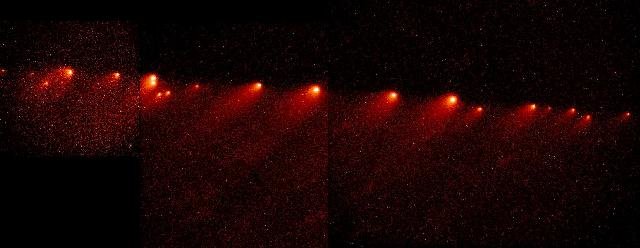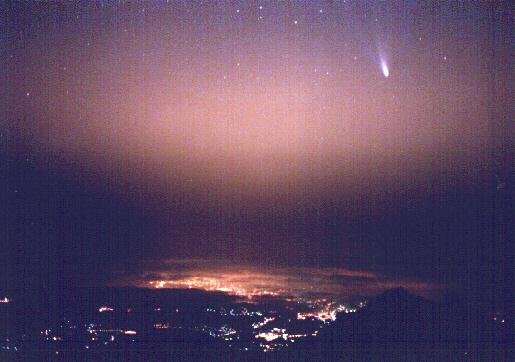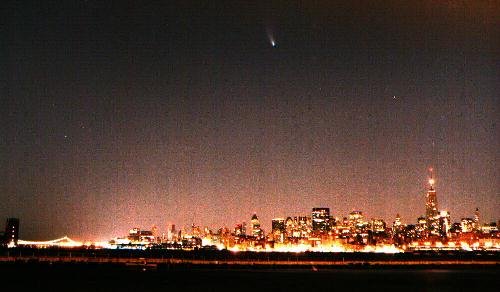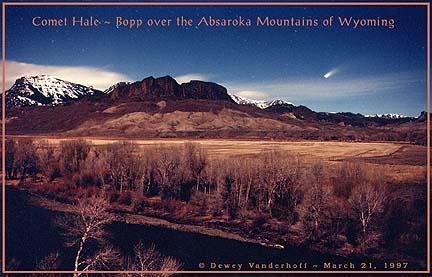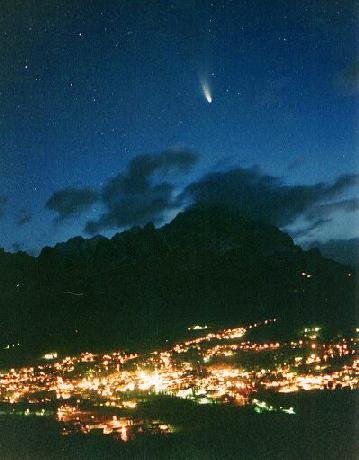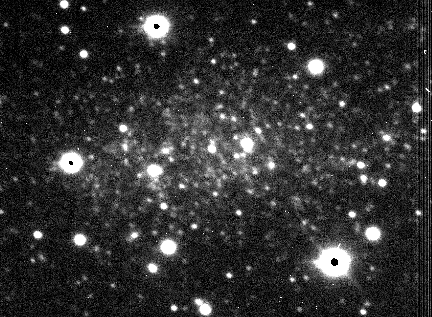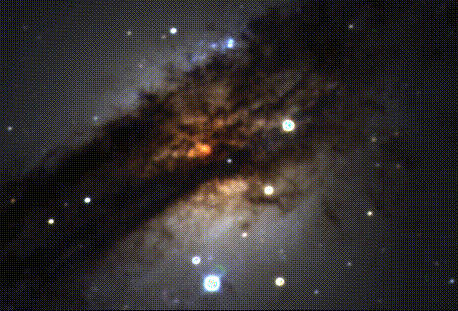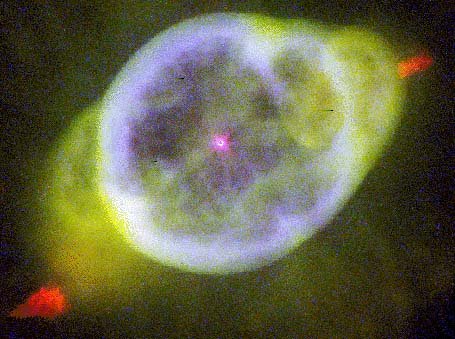NASA APOD #643-652
#643 A String Of Pearls
Credit: March 23, 1997
“Comet Shoemaker-Levy 9, named after its co-discoverers, was often referred to as the "string of pearls" comet. It is famous for its unusual appearance as well as its collision with the planet Jupiter! The comet's original single nucleus was torn to pieces by Jupiter's strong gravity during a close encounter with the solar system's largest planet in 1992. The pieces are seen in this composite of Hubble Space Telescope images to be "pearls" strung out along the comet's orbital path. In July of 1994 these pieces collided with Jupiter in a rare and spectacular series of events."
Copyright: Public domain
#644 The Weather on Mars
Credit: March 24, 1997
“Would Mars be a nice place to visit? Sometimes. Much of Mars undergoes severe changes in climate during its orbit around the Sun, ranging from extreme cold to temperatures enjoyable by humans. But Mars is usually a nice place to visit for hardy spacecraft, and in fact the Mars Pathfinder and Mars Global Surveyor missions are currently headed for the "Red Planet." In preparation for the scheduled Mars Pathfinder landing on July 4th, 1997, the Earth-Orbiting Hubble Space Telescope recently took the above high resolution photograph. The picture shows the onset of Martian summer (northern hemisphere) when, apparently, the northern polar cap recedes to uncover dark sand dunes. "
Copyright: Public domain
#645 Hale-Bopp Brightest Comet This Century
Credit: March 25, 1997
“A comet as bright as Comet Hale-Bopp is very rare indeed. No comet has emitted or reflected this much light since possibly the Great Comet of 1811. However, since Comet Hale-Bopp is across the inner Solar System from us, it does not appear as bright as Comet West did in 1975. The Great Comet of 1996, Comet Hyakutake, was relatively dim but also appeared bright since it passed close to the Earth. Above, Comet Hale-Bopp was photographed high over the town of Las Palmas of the Spanish Canary Islands, on March 11th. "
Copyright: Public domain
#646 The City Comet
Credit and Copyright: March 26, 1997
“Undaunted by the artificial glow from one of the most famous urban skylines on Earth, comet Hale-Bopp shines above the city of New York, USA. Photographed on March 23rd, this view from New Jersey shows the Hudson River in the foreground, the Empire State Building at the right, the George Washington Bridge at the left, and the comet with a visible tail above. The comet lies at a distance of about 120 million miles from New York. As bright as this comet has turned out to be, it might have been even brighter. On May 6, Hale-Bopp's orbit will take it within about 10 million miles of the point in the Earth's orbit which was occupied by planet Earth itself in early January. If the comet had also reached this point in January, it would have come almost as close to Earth as comet Hyakutake did last year. At that distance, Hale-Bopp might have been 100 times brighter than it is now, reaching -5th or -6th magnitude!"
Copyright: Public domain
#647 Comet Country
Credit and Copyright: March 27, 1997
“Moonlight illuminates the landscape and lends a painterly quality to this beautiful photograph of the Absaroka mountain range, located along the Montana-Wyoming border near the USA's Yellowstone National Park. In the foreground lies the North Fork of the Shoshone River. The snow-covered peak rising 10,500 feet on the left is Jim Mountain, while Comet Hale-Bopp graces the western sky. Inspired by painters of the American West, like Fredric Remington, Charles Russell, and George "Dee" Smith, photographer Dewey Vanderhoff of Cody, Wyoming has taken advantage of the double blessings of a bright Moon and a bright comet to produce this breathtaking image."
Copyright: Public domain
#648 A Comet In The Sky
Credit: March 28, 1997
“It has been suggested that Comet Hale-Bopp will become the most viewed comet in Human history. Presently, for denizens of the Earth's northern hemisphere, this bright comet is certainly a lovely and inspiring sight -- visible here crowning the sky above Cortina d'Ampezzo, Italy on March 20. Based on orbital calculations, this comet's last passage through the inner Solar System was approximately 4,200 years ago. Principally because of changes caused by the gravitational influence of Jupiter, Hale-Bopp should pass this way again in a mere 2,380 years. Comets come from the outer reaches of the Solar System where they reside, frozen and preserved. Astronomers analyzing their structure and composition as comets swing near the Sun seek a glimpse of the conditions during the Solar System's formative years."
Copyright: Public domain
#649 The Closest Galaxy: The Sagittarius Dwarf
Credit and Copyright: March 29, 1997
“What's the closest galaxy to our Milky Way? For many years astronomers thought it was the Large Magellanic Cloud (LMC). But the seemingly insignificant fuzzy patch shown above turned out to be part of a galaxy that is even closer. Deemed the "Sagittarius Dwarf", this small galaxy went unnoticed until its discovery in 1994 by R. Ibata, G. Gilmore and M. Irwin (RGO). The reason the Sagittarius Dwarf hadn't been discovered earlier is because it is so dim, it is so spread out over the sky, and there are so many Milky Way stars in front of it. The distance to the Sagittarius Dwarf was recently measured to be about one third of the distance to the LMC. Astronomers now believe that this galaxy is slowly being torn apart by the vast gravitational forces of our Galaxy. "
Copyright: Public domain
#650 Dusty Galaxy Centaurus A
Credit: March 30, 1997
“One of the most unusual galaxies known, Centaurus A, is pictured above. Cen A is marked by dramatic dust lanes that run across the galaxy's center. These dust lanes are so thick they almost completely obscure the galaxy's center in visible light. Our Milky Way Galaxy contains dust, but not in the same proportion. Cen A is also unusual compared to a normal galaxy because it contains a higher proportion of young blue stars, is a very strong source of radio emission, and has a unique structure. Cen A is thought to be the result of the collision of two normal galaxies."
Copyright: Public domain
#651 NGC 3242: The 'Ghost of Jupiter' Planetary Nebula
Credit: March 31, 1997
“It's a weed, it's Jupiter, no it's - actually planetary nebula NGC 3242. After a star like our Sun completes fusion in its core, it throws off its outer layers it a striking display called a planetary nebula. NGC 3242 is such a planetary nebula, with the stellar remnant white dwarf star visible at the center. This nebula is sometimes called "The Ghost of Jupiter" for its similar appearance to the familiar planet. NGC 3242 is much farther away however, than the measly 40 light-minutes distance to Jupiter. In fact, by comparing the apparent expansion rate with the actual rate determined from Doppler studies, astronomers have estimated the distance to NGC 3242 to be about 1400 light-years away. The red FLIERs visible near the edges of the nebula remain mysterious. "
Copyright: Public domain
#652 Hale-Bopp and Andromeda
Credit and Copyright: April 01, 1997
“Which is closer: the comet or the galaxy? Answer: the comet. In its trek through the inner Solar System, Comet Hale-Bopp has passed nearly in front of the Andromeda Galaxy (M31), seen on the lower left. At the time of this picture, March 27th, Comet Hale-Bopp was about 10 light-minutes from the Earth, while M31 remained about 3 million light-years distant. By contrast, light can cross the Earth in about 1/20th of a second, and light takes about one second to reach Earth's Moon. Comet Hale-Bopp is one of the largest comets ever recorded, and although its' nucleus has never been photographed, it is estimated from brightness and spin measurements to be about 40 kilometers across. In contrast, Comet Halley in 1987 was measured to be 15 km, and Comet Hyakutake in 1996 was estimated to be no more than 10 km. "
Copyright: Public domain
Upvote! Resteem! Comment! As you like it! Thank you for attention!
